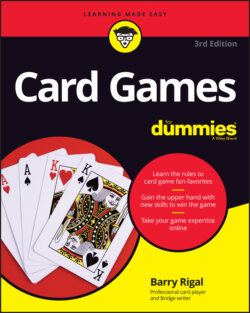Читать книгу Card Games For Dummies - Barry Rigal - Страница 14
CARD GAMES THROUGH THE AGES
ОглавлениеSome form of playing cards existed in China, at least 80 years and maybe as much as 250 years before they surfaced in Europe. The earliest known Chinese cards had four suits, described in mid-15th-century sources, and featured 38 cards: 9 each in three suits and 11 in the fourth. Similar cards are used in parts of China and Southeast Asia to this day, though the deck composition and designs are not identical.
Although some scholars claim the Saracens or the Persians invented card games (the Persians certainly seem to have invented Poker), the Mamelukes of Egypt appear to be credible ancestors of modern card games. A Mameluke deck from around 1400 A.D. consists of 52 cards with suits of swords, polo sticks, cups, and coins.
National standard designs appeared in the late 15th century. Swiss decks (with shields, flowers, bells, and acorns) and German decks (with hearts, leaves, bells, and acorns) appeared by 1475. The French deck (with spades, hearts, diamonds, and clubs) first appeared by 1480.
In Great Britain, The Worshipful Company of Playing-Card Makers was set up in 1628 to produce cards, and a tax was introduced on every deck. Laws were also enacted to ban the import of cards; from then on, you could only play with cards of domestic origin. The year 1862 was very significant for the rise in popularity of playing cards. Along with a fall in the duty charge of playing cards, printer Thomas de la Rue patented the process for mass-producing cards. From then on, well-designed playing cards were in plentiful supply.
